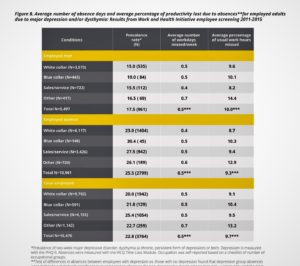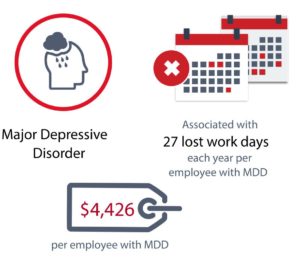Workforce Mental health is a public health issue and an economic issue. Rising rates of mental disorders impact employers’ health care expenses. They also contribute to productivity losses that negatively affect their bottom lines. To increase returns on their investments, employers should know about the prevalence of mental health problems and the costs of mental health care. Then, they can make the necessary changes to the work environment to support the well-being of all of their employees.
Prevalence in the Workplace
In the United States, one in five adults has a clinical mental disorder. Anxiety disorders are the most common, followed by substance use disorders and mood disorders such as depression. Nationally, about 76% of employees reported that they struggled with their mental health, and 42% were diagnosed with a clinical mental health disorder. A report from One Mind at Work estimates that for a business with 10,000 employees and a male/female ratio of 45%/55%, nearly 1,000 workers of their workers suffer from depression.

Mental health problems present challenges across sectors. In one study, researchers found that white–collar, blue–collar, and sales and services workers missed an average of a half-day of work each week due to depression. Some estimates suggest that major depression alone is costing employers $31 billion to $51 billion per year in lost productivity. The World Economic Forum reports that by 2030, the global costs of mental health problems will total over $6 trillion.
The Costs of Poor Workforce Mental Health
Health Insurance
Mental health challenges in the workforce can lead to higher health care costs for employers. Some employers may not be aware, though, of exactly how much mental health care drives up insurance costs. One estimate showed that an employed person with depression has an annual average healthcare cost of over $10,000, which is more than twice that of an employee without depression ($4,584).
Also, studies have found that mental health disorders are associated with certain types of chronic illnesses, such as diabetes and heart disease. It can be challenging and costly to treat co-occurring disorders at the same time, particularly if one disorder is exacerbating the other. One study showed that part of the high costs of depression comes from the additional care needed to address co-occurring chronic illnesses.
Absenteeism
Employees with mental health disorders can experience emotional and physical symptoms that cause them to miss work. As a result, mental health problems can mean lost productivity, which is costly for employers. Employees with depression miss about 27 days of work per year compared to their peers without depression. The per capita cost of absences due to depression is $4,426.59.

Presenteeism
Presenteeism refers to employees who can come to work, but their mental health symptoms impact their productivity. For instance, employees with depression often have problems with time management, concentration, physical tasks, attention to detail, and communication. In other words, mental health problems can lead to missed deadlines, difficulties with project management, and other oversights that cost employers time and money. The following figure demonstrates that presenteeism from depression costs more per employee than conditions such as obesity, headaches, diabetes, and arthritis.
Recruitment and Rehiring Costs
Finally, mental health challenges can result in increased spending on recruitment and retention. Employees with depression are 20% more likely to become unemployed after two years compared to their counterparts. Higher turnover rates mean more money spent on recruitment, hiring, and retraining new employees. A study from the Institute for Research and Labor Employment suggests that in California, it costs an average of $4,000 to replace an employee. These costs will vary depending on the size of the business, the sector, and other employer-specific factors.
What employers should do
The American Psychological Association reports that nationally, the workplace is the third-leading cause of stress. An employee’s stress levels and working environment can add hurdles to their already challenging mental health situation. However, since adults spend so much of their time at work, employers are in a unique position to make strategic decisions to improve employee mental health and well-being.
Choosing to invest in mental health prevention and intervention options saves employers money on healthcare and other costs. For every $1 invested in evidence-based programs, employers can save $2-$4 on other expenses.
Policies and practices like manageable workloads, supportive supervision, and clear roles and responsibilities can all contribute to a supportive workplace environment. Employers’ investments in mental well-being not only creates a happier, healthier workforce, but also boosts profit margins along the way.
If you would like to learn more about Workforce MHQ, reach out today to schedule a conversation.

